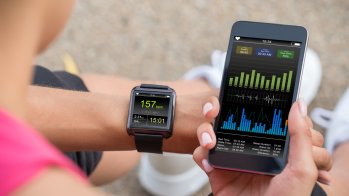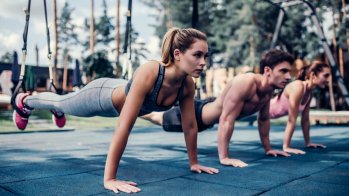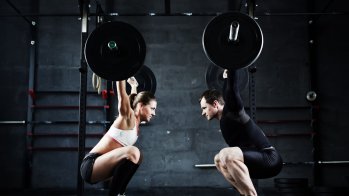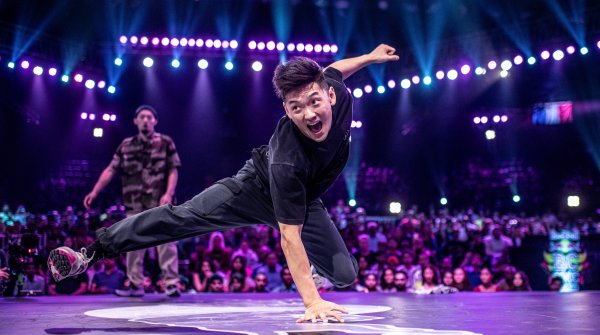
In the U.S., one thing is certain: fitness trackers, smartwatches and other wearables will be the number one fitness trend in 2019, at least according to the annual survey of health and fitness professionals published in the November issue of ACSM Health & Fitness Journal.
Wearables are an important trend, but not always the most important without controversy. ISPO.com asked around the industry and gathered more insights and outlooks. The result is the 9 most important fitness trends for 2019.
"Fitness is much more than 'just a workout'; it has become an individual interpretation of quality of life, a culture of our society," says Niels Nagel, Head of Office at the German Industry Association for Fitness and Health (DIFG). For him, this also includes fitness nutrition, which should ideally be sustainable. Some companies offer fairly produced products for athletes, for example. But sustainably produced training equipment is also gaining in importance.
But sustainable also means sustainable training: "People want to feel better and more dynamic in their everyday lives, so they go to the gym. Losing weight or building muscle are no longer the biggest drivers," says Marius Keckeisen, CEO at Blackroll. "More and more, it's about working with the client in the time available in a way that builds flexibility, musculature and fitness. And in such a way that the customer can go through life pain-free in the long term. The focus is not on achieving maximum results in one area."
Nagel adds, "The trend is to design offerings so that they are available on a flexible basis." Workers should be given the opportunity to exercise despite shift work or other physical exertion. This is the only way to achieve a sustainable change in behavior, i.e. to integrate fitness into everyday life on a permanent basis.
Time to measure up. After all, the more data in circulation, the easier it is to compare performance. Many fitness enthusiasts are now taking advantage of this to measure themselves in so-called competitions. Younger fitness fans in particular are showing great interest in these competitions.
However, Nagel points out: "High-impact training and competitive sport require not only passion but also, among other things, careful preparation, coaching and the opportunity for sufficient regeneration. If you are healthy, you are allowed to push yourself and challenge yourself. For the vast majority of us, however, this should not become a daily routine and an end in itself, in addition to family and job." With it he speaks also to Fitness Events like Hyrox. So competition for the masses still needs to be developed in the fitness sector. A challenge that the industry will have to overcome in the coming years, especially with regard to young people interested in competition.
The 8 Most Important Fitness Trends for 2019 in Pictures
Group training goes hand in hand with the big events and competitions. For many, the motto is now: Everything in the community. On the one hand, this is for comparability with colleagues, and on the other hand, it's also fun. In order to motivate each other and exchange tips and tricks, the smartphone, social media or apps such as Freeletics or Runtastic already help. "Concepts in which people train together in groups have many fans," knows Blackroll CEO Keckeisen. "These motivate many participants significantly more than working out alone. On the one hand, it becomes a social experience, but also a competition."
The fact that sports are particularly fun in a group is well known: team sports have enjoyed great popularity for centuries. The fitness industry has recognized this: In some areas, it is also gradually developing into a team sport. Aerobics has been around for decades, but in recent years there have also been a noticeable number of Zumba or Piloxing classes. And in the cities, running communities or outdoor training sessions are forming in large groups.
Training to become a personal trainer has become much more demanding in recent years. This is because fitness trainers are becoming increasingly important for individual fitness enthusiasts and should be able to respond to them more and more. The qualification must be right. Many fitness enthusiasts crave one-on-one attention to achieve optimal results. In addition, new generations are conquering the gyms and they want to be well looked after. For this, there are now various certifications in the fitness sector. Blackroll also trains coaches for its own products and now has about 4000 coaches.
In addition, personal trainers are also increasingly becoming entrepreneurs, which in turn goes hand in hand with another trend: fitness trainers are increasingly offering their work in their own small boutique studios, in order to offer a small special target group a high-quality training program. "If you consider that the fees there are between 80 and 130 euros, that's an extremely interesting concept economically," Nagel says - and that's "about the increased benefits and individual attention for the trainee as well."
Until 2017, HIIT was still the number one fitness trend in the US. Now, high-intensity interval training still ranks third. So it's the perennial favorite among trends - despite warnings about increasing risk of injury. But why is HIIT, through which you can achieve fast fitness results, still a trend around the world? "In the field of HIIT, there are now very many different concepts. There is already a lot going on here and the range is becoming more specific," says Keckeisen. "The requirement to achieve a maximum result in a short time is in line with the fast-paced zeitgeist."
Nagel also says HIIT is becoming increasingly interesting "for other target groups, such as those who want to train very effectively." Dosed use of HIIT exercises can also have a positive effect in the context of health-oriented training, such as for diabetics. "What is important here is supervision by a qualified trainer so that unintended side effects, such as overloading, can be avoided," Nagel explains.
One's own health is no longer just a matter for each individual. More and more companies are promoting the health of their employees through corporate fitness offerings. Many of them work together with fitness studios or personal trainers. After all, healthy employees also benefit the company.
Some companies already offer very good deals in cooperation with fitness studios. This starts with lower membership prices and ends with the company paying for its own treatments. Larger companies even install equipment on their work premises or offer fitness exercises with personal trainers there. This way, you can get a basic workout just before work, during your lunch break or in the evening with little effort.
What's new is that companies are no longer just using gyms to motivate employees to exercise: "The aspiration is to perhaps work out in a gym today, go swimming tomorrow, go golfing the day after, or take advantage of other leisure activities that are integrated into framework agreements," Nagel explains.
Data exchange and data use via wearables and smartphones will continue to gain in importance in 2019. Above all, however, it is important to use the right data, Nagel emphasizes in an interview with ISPO.com. After all, the trackers not only collect fitness data, but also health data. "In the future, digitization will give exercisers more information to make training safer and more effective. If, for example, an illness is on the horizon, there's no point in training. No matter how motivated you are. And that's where having an early warning device on your wrist can be helpful"says Nagel.
Currently, sensors on the skin are reducing. "Much more accurate sensors on the body will prevail here in the long term, however," Keckeisen is convinced. "With some wearables, the data is simply too poor and the question arises as to why I am recording data in the first place." For him, it is therefore conceivable that fitness trackers will no longer dangle from the wrist for too long at all. Nagel agrees, "Maybe in the near future we'll see the first sensors on the market that are administered orally or implanted under the skin." 2019 may be too early for that.
The smartphone, however, Nagel thinks, will remain an integral part of life, and therefore fitness, unlike the smartwatch. It could underpin its position as a wearable fitness giant in the new year, experts agree.
In the age of the smart home, it's not just wearables and apps that are networked, but increasingly the devices as well. When the cross trainer communicates with the treadmill and both synchronize the athlete's performance and load, this enables a varied workout that is optimally tailored to the fitness level. Some gym operators use chips for networking, while others use the wearer's smartwatch. Thanks to the collected data, the fitness equipment adjusts to the user in the best possible way, which also helps inexperienced gym users.
For example, if an athlete switches from the treadmill to the cross trainer, the latter adjusts to the user thanks to the networking. If he then switches to the shoulder press, the equipment can be programmed optimally for the respective training goal thanks to the collected data. The machines now know how much effort the user can handle. Another plus: Not only do the respective manufacturers network their training devices and apps with each other, this is now also happening across manufacturers. The industry is forming cooperative ventures to network a wide variety of manufacturers with one another.
Health & Fitness auf der ISPO Munich 2018 in Bildern
It's not entirely new that seniors are also hitting the gyms. But the trend is picking up. Because the fitness industry has opened up: "The growth in senior fitness is the consequence of a broad acceptance of the fitness industry," says Nagel, which is particularly due to the "positioning as a health provider".
In addition, many trends are working together here:
- The simpler operation of the equipment, which is becoming easier to set up or can also be set up automatically
- Better certified trainers who take care of seniors and offer them special training options. This includes explanations and assessments so that seniors are introduced to fitness life in a holistic way
- Seeking social contact in sports, which fuels fitness groups.
Seniors therefore now feel much more comfortable in the studios than they used to.
 Know-HowThe 11 Best TRX Exercises
Know-HowThe 11 Best TRX Exercises
- Awards
- Mountain sports
- Bike
- Fitness
- Health
- ISPO Munich
- Running
- Brands
- Sustainability
- Olympia
- OutDoor
- Promotion
- Sports Business
- Textrends
- Triathlon
- Water sports
- Winter sports
- eSports
- SportsTech
- OutDoor by ISPO
- Heroes
- Transformation
- Sport Fashion
- Urban Culture
- Challenges of a CEO
- Trade fairs
- Sports
- Find the Balance
- Product reviews
- Newsletter Exclusive Area
- Magazine








































